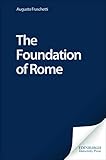The Foundation of Rome / Augusto Fraschetti.
Material type: TextPublisher: Edinburgh : Edinburgh University Press, [2022]Copyright date: ©2005Description: 1 online resource (224 p.)Content type:
TextPublisher: Edinburgh : Edinburgh University Press, [2022]Copyright date: ©2005Description: 1 online resource (224 p.)Content type: - 9780748621200
- 9781474468275
- 937.601
- DG52
- online - DeGruyter
- Issued also in print.
| Item type | Current library | Call number | URL | Status | Notes | Barcode | |
|---|---|---|---|---|---|---|---|
 eBook
eBook
|
Biblioteca "Angelicum" Pont. Univ. S.Tommaso d'Aquino Nuvola online | online - DeGruyter (Browse shelf(Opens below)) | Online access | Not for loan (Accesso limitato) | Accesso per gli utenti autorizzati / Access for authorized users | (dgr)9781474468275 |
Frontmatter -- Contents -- Translators' Note -- Abbreviations -- Preface -- 1. The twins -- 1. The Vestal and the she-wolf -- 2. Grandparents and ancestors -- 3. An adolescence in the bosom of 'nature': the world of the luperci -- 4. At the conquest of Alba -- 2. The foundation -- 1. On the site of Rome: taking the auspices, and the death of Remus -- 2. 'Roma Quadrata' and the pomerium -- 3. The civic body and its organs -- 4. The abduction of the women and the war against the Sabines -- 5. From the domestic fires of the curiae to the hearth of Vesta -- 6. Archaeology and the 'rights' of criticism -- 7. Settlements and festive rituals: from Romulus to Tullus Hostilius -- 3. Romulus' government and his wars -- 1. Romulus 'the lawgiver' -- 2. The calendar -- 3. The joint reign of Romulus and Titus Tatius -- 4. Romulus' wars -- 4. The disappearance of the founder: Romulus 'cut into pieces' or his apotheosis -- 1. The founder's disappearance: two traditions -- 2. The ascent into heaven: the highly ambiguous characteristics of a tradition -- 3. Romulus and the god Quirinus -- 4. The dismemberment of the body: comparativist perspectives -- 5. Romulus in the South Seas -- 6. A Roman view: the disappearance of Romulus and the foundation of the comitia -- 7. The body of Romulus and the origins of the patriciate -- 8. The death of Romulus and the destiny of Caesar -- Epilogue -- Appendix I. The ambiguous status of Tarpeia -- Appendix II. A wall at the foot of the Palatine Hill -- Notes -- Bibliography -- Index
restricted access online access with authorization star
http://purl.org/coar/access_right/c_16ec
Augusto Fraschetti describes the legends surrounding the origins, foundation and early history of Rome, the significance the Romans attached to the legends of their origins, and the uses to which they put them.Between 1000 BC and 650 BC a cluster of small, isolated groups of thatched huts on the Roman hills became an extensive and complex city, its monumental buildings and large public spaces evidence of power and wealth. Two competing foundation legends accounted for this shift, one featuring the Trojan fugitive Aeneas and the other the wolf-reared Romulus and Remus. Both played a significant role in Roman thought and identity, preoccupying generations of Roman historians and providing an important theme in Roman poetry.In the last two centuries the foundation era of Rome has been the subject of extensive investigations by archaeologists. These have revealed much that was previously a mystery and have allowed the piecing together of a coherent account of the early history of the city. Professor Fraschetti considers this evidence and the degree to which it supports or undermines the legends, Roman documentary accounts, and the work of modern scholars. He reveals what now seems the most probable history of Rome's origins and rise to regional pre-eminence.
Issued also in print.
Mode of access: Internet via World Wide Web.
In English.
Description based on online resource; title from PDF title page (publisher's Web site, viewed 02. Mrz 2022)


